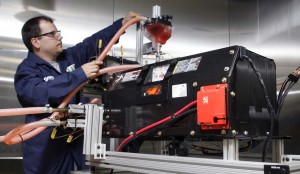If all goes according to plan, General Motors will be producing tens of thousands of plug-in hybrids annually in the coming years. So, what to do with the batteries when it comes time to sent vehicles like the Chevrolet Volt to the scrapyard?
Even after a decade of use, the lithium-ion battery pack in the typical Volt should have 70% of its capacity left, according to Pablo Valencia, GM’s senior manager for battery lifecycle management. And that means that even as the old Volt is melted down for scrap, those batteries could find new life propping up the nation’s electrical grid.
Starting next year, GM will partner with energy systems giant ABB to begin testing the use of Volt batteries as an energy storage solution that could serve a variety of purposes from preventing blackouts to helping level out the ups-and-downs of alternative energy sources like wind and solar.
“With 33 batteries, I’d be able to give you an uninterruptible power supply to approximately 50 houses for up to four hours during a blackout,” explained Valencia, during a teleconference briefing from the Plug-In Conference in Raleigh, North Carolina.
GM is just one of many makers looking at ways to use – and re-use the batteries on electric vehicles to support the electric grid. Toyota has been exploring opportunities where some of its hybrid models could be used to help level out the energy supply in Japan as the result of the nuclear meltdown triggered by that country’s March 11 earthquake and tsunami.
But the partnership with ABB could turn talk into action, especially if next year’s test program – which will involve several unnamed but “forward-thinking” utilities proves successful.
Preventing blackouts is one potential use, but another would be to help load-level the grid. Right now, utilities must put in place enough capacity to readily handle the highest possible demand. In the future, they might call on a network of battery storage systems to provide energy during demand spikes.
Meanwhile, battery backup systems could store energy produced when alternative green sources at operating at peak, then pump that back out onto the grid at night, when solar systems stop working, or during lulls when wind generators are out of operation.
Such concepts are, for the moment, just theoretical, however. It will likely be another decade before the first Volts start to reach the end of their lifecycle freeing up their “nearly-new” batteries for other applications. But the upcoming test could indicate whether utility grid planners can work the concept into their equations as they start to think about the anticipated growth in U.S. electric demand.
“This is a new part of the equation,” said ABB executive Sandeep Bala.
There’s still a lot of uncertainty, however, and utilities will want to ensure the battery packs will be able to deliver what’s promised.
“We want to prove we’re moving beyond talk and into hardware,” said Valencia.

